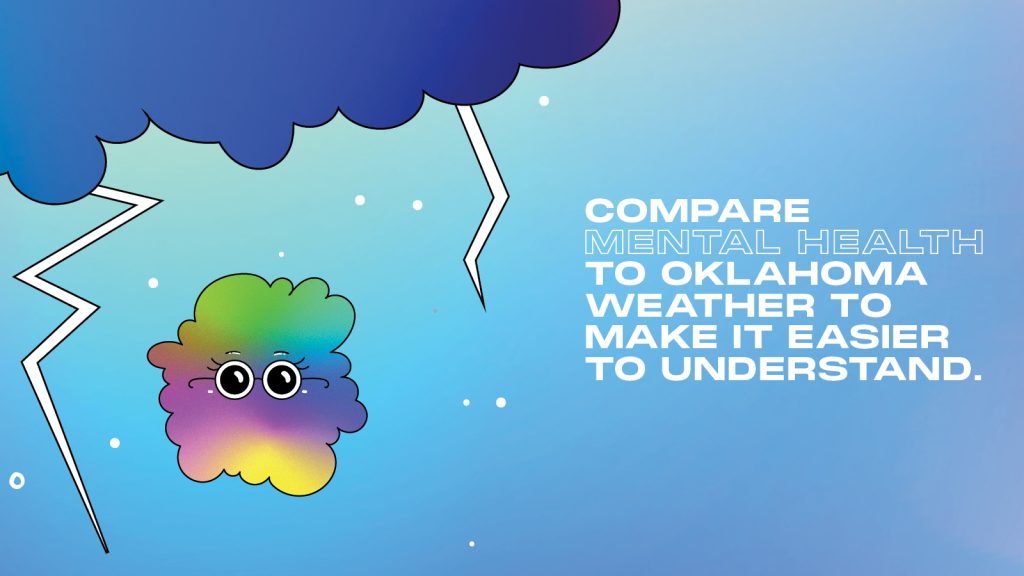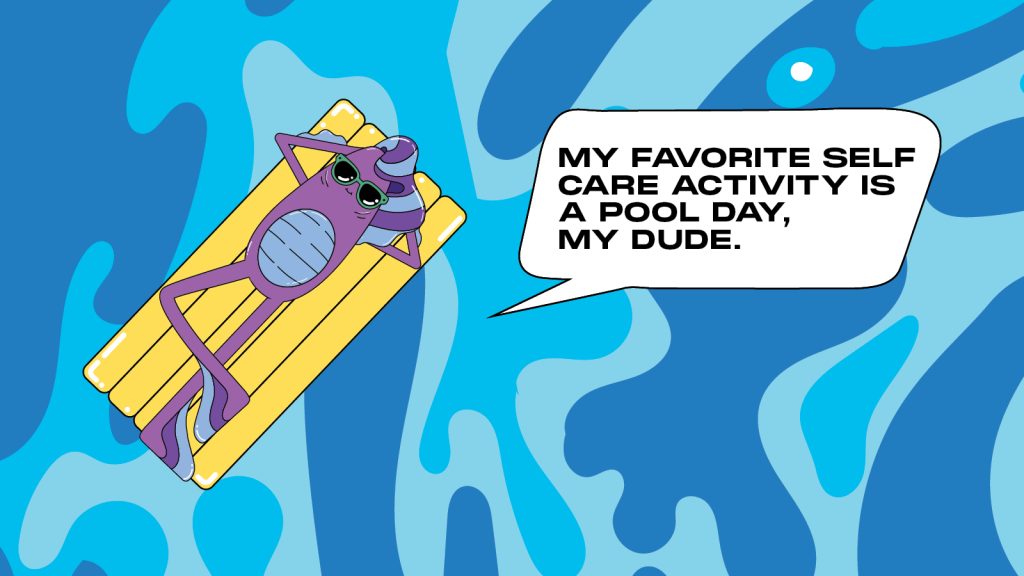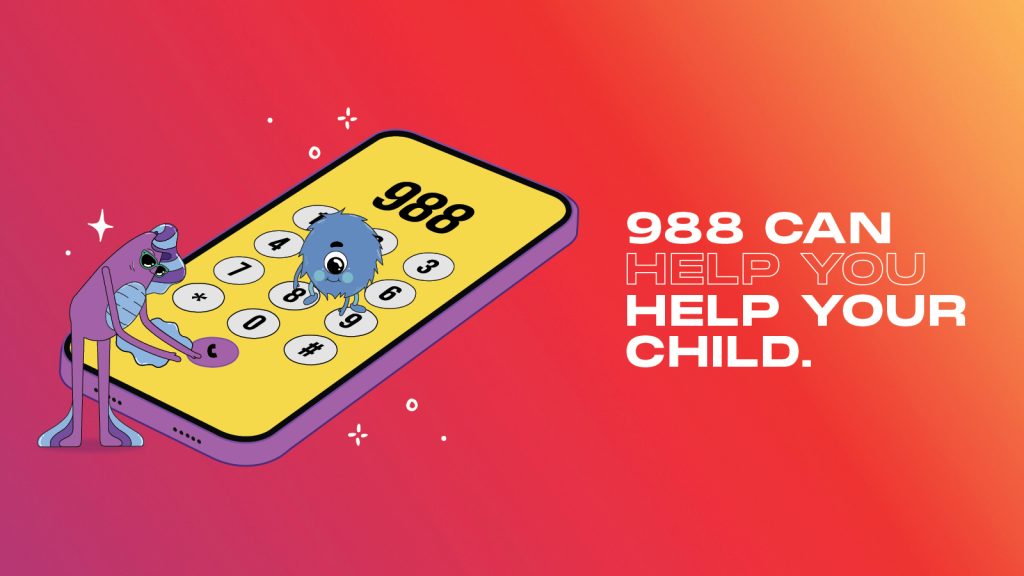From social media to high-stress classes to figuring out the future, growing up can be a heavy weight to bear. In Oklahoma, our children are at a heightened risk of mental health struggles. More than 54,000 Oklahoma kids live with depression, and 1 in 10 Oklahoma students have reported attempting or thinking about suicide in the past 12 months.
The good news? We can change that together. If you’re wondering how to introduce mental health or talk about depression or suicidal thoughts with your child, you’ve come to the right place. Let’s talk about how to approach the subject with ease, with even the littlest Oklahomans.
And keep an eye out for some special tips from the 988 Call Center Critters.
Talk Often and Early
It’s never too early to check your child’s mental health temperature. While you don’t have to talk about depression or suicide with your little ones, you can create an environment where talking isn’t taboo by actively listening and making yourself an askable parent. It can be as simple as checking in during the car ride after school, while playing catch, or while coloring together.
![Conversation starters from 988 Call Center Critter, Corty, including "How was your day at school?", "It's okay to feel sad. We all feel sad sometimes", "How did [blank] make you feel?", "If the way you're feeling were a monster, what would it look like?" and "Do you want to talk about [blank]?"](https://988oklahoma.com/wp-content/uploads/2024/01/988_0124_Blog-Images_Help-Your-Child_Conversation-Starters-1024x576.jpg)
The pressures of life can feel amplified and alienating for the kids and teens, and having an adult they can trust to talk things out is crucial. When they know it’s safe to talk about tricky feelings, it encourages emotionally healthy reactions should they struggle with their mental health in the future.
Use Age-Appropriate Terms
Talking about mental health doesn’t have to wait until they’re “old enough.” You just have to make the topic understandable to their development level. You can start a healthy dialogue early by guiding your child when they’re upset or noticeably sad. For children, stick to simpler terms and analogies, and adapt your language as they grow. Once they reach teenage years, kids can typically handle more direct, complex conversations. You might even choose to share your own struggles to relate to them or use examples in TV shows or movies to start a dialogue.
Always take time to remind your child that you love them, validate their feelings, listen without judgment, and let them know that bad feelings are temporary.

Encourage Self Care
Mental health is part of our physical health, and that’s why a self care routine can be a gamechanger at any age. Along with physical health care like exercise, healthy meals, and personal hygiene, kids can learn to prioritize their mental health by journaling, unwinding with quiet activities like reading or drawing, or getting some fresh air on a family walk. As they get older, having these activities already built into their routine can help them self-regulate and manage their emotions easier.

Use the Call Center Critters
If you’re still feeling intimidated, 988 Oklahoma has a few special friends who can help. The Call Center Critters are a ragtag bunch of misfits ready to help their fellow Oklahoman talk about their mental health. Get started by taking the “Which 988 Call Center Critter Are You?” quiz, then use the results to start a conversation about positive reactions and behaviors.
For example, Corty has a tendency to feel a little anxious, so she uses breathing techniques and coping skills to calm herself down. Okla is always putting on a happy face, but that doesn’t mean he doesn’t feel down from time-to-time. And Lucille? She’s an excellent listener who is always there for her friends, but we should always check on the helpers too.
Our PSA is also a catchy way to introduce the 988 Mental Health Lifeline to young Oklahomans. Apologies if it’s already stuck in your head.
Respect Their Boundaries
If you’re worried about your child and they don’t want to talk immediately, that’s okay. Kids deserve to have their boundaries respected just as much as adults. Though it may feel frustrating or worrisome as a parent, give your child time and be patient. They may feel embarrassed or like they might be in trouble, and prodding before they’re ready to talk could possibly close them off further. It’s also a good idea to avoid the subject when emotions are already running high, such as after a stressful day or during a disagreement.
If your child is up for it, you can always offer alternatives to a one-on-one conversation, such as writing a letter or texting about how they’re feeling.
Talk to the 988 Mental Health Lifeline
988 is more than just a lifeline in times of crisis. It’s a free resource that can help you help your child. If you notice your child is struggling with their mental health, you can call or text 24/7 to talk with a trained crisis counselor who can guide you on how to best assist your child. For older kids and teens, they can call or text 988 directly if they don’t feel comfortable talking to you or another adult. Conversations are always confidential and private.

Be Direct About Suicide
One of the most powerful ways you can support your child’s mental health is to treat the word “suicide” as a conversation topic, not a curse word. Because of stigma and fear, many parents and caregivers are afraid to ask if their child is thinking about suicide. Some fear that talking about it could actually encourage suicidal behavior, but many studies have shown that this is not case. In fact, asking your child if they’re thinking about suicide may come as a relief and actually reduce the likelihood of suicide.
If you’re worried that your child is thinking about taking their own life, ask. By breaking down that invisible wall, you could be creating the quickest path to the help they need.
